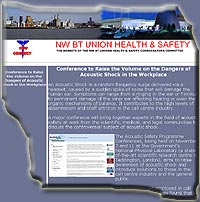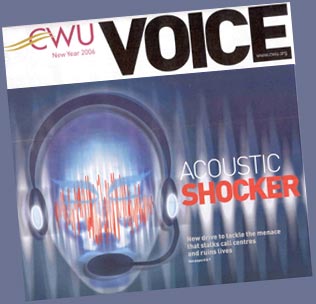Acoustic Safety - The New Contact Centres Issue!
Following the Acoustic Safety Programme's conference held last November, and the forthcoming Noise at Work Regulations, the issue of acoustic shock will be a major health and safety issue for all Union Safety Reps within the industry.
 With the CWU's USR and branch Officer, Gill Gillet featuring again in the CWU Voice on this issue; it is clear that Acoustic Safety is as important to call centre workers as that of WRULDs and Stress.
With the CWU's USR and branch Officer, Gill Gillet featuring again in the CWU Voice on this issue; it is clear that Acoustic Safety is as important to call centre workers as that of WRULDs and Stress.
Whilst we have seen a 45% increase in cases of WRULDs according to research figures issued last year, the current reports of Acoustic Shock are just the tip of the ice burg in the view of the CWU and those attending the conference in November.
NW BT Unions H&S Co-ord member and director of Oasis Health & Safety Ltd, Chris Ingram, attended the Acoustic Safety Programme's conference on Acoustic Safety last November. He said:
" The conference represented a major initiative for the UK and brought together, acoustic specialists,health & safety specialists, trade unions and solution providers with the one aim of preventing a major epidemic in the UK's contact centre industry of acoustic shock.
Sadly as with all things to do with health & safety, the industry bodies representing employers within the sector still refuse to acknowledge the serious implications this issues has for the health of their employees and the health of their companies."
Despite being involved in the conference and headlined as attending, neither BT nor GNetcom turned up. Given that immediately prior to the conference, the newly supplied GNetcom system failed in preventing major incidents of acoustic shock in BT Contact centres throughout the UK, this is hardly surprising.
 Lord Hunt, who opened the conference stated that there are at least 170,000 people in Britain today suffering from deafness or Tinnitus caused by work-related conditions with hundreds of legal cases pending.
Lord Hunt, who opened the conference stated that there are at least 170,000 people in Britain today suffering from deafness or Tinnitus caused by work-related conditions with hundreds of legal cases pending.
"Taking action early can prevent these problems," said the minister, "the most important advice for call centres is to have a traceable reporting system for headset users, and that headsets should have built-in protection against high noise levels."
Attending the conference was Dave Joyce National Health & Safety Officer, CWU who advised attendees that: " The CWU campaign on Acoustic shock started some 16 years ago they brought it to the attention of BT following incidents investigated by CWU Union Safety Reps. Since then numerous claims have been settled with the company as a result of the damage to individuals exposed to incidents of acoustic shock."
Dave stated that more rigorous testing of new equipment and further research with the involvement of the HSE is required. He gave the example of investigation by the HSE and recording of noise levels at BT's Leicester 150/151 centre. There was also a need for a greater demand from the industry for manufacturers of telephone equipment and headsets to guarantee equipment is protected from the risk of acoustic shock events occurring.
 The current edition of the CWU Voice headlines the need for this issue to be taken seriously by employers and employees alike in order to prevent a major health issue from continuing unabated as it currently has.
The current edition of the CWU Voice headlines the need for this issue to be taken seriously by employers and employees alike in order to prevent a major health issue from continuing unabated as it currently has.
"The CWU is steadfastly campaigning for recognition of acoustic shock and seeking a technological solution to the problem," Dave is quoted as saying.
While highlighting the close work between the union and BT, he adds: "There are lots of employers in the industry saying 'we don't have a problem; acoustic shock doesn't exist. ..' when they haven't even asked their workforce."
Continuing with the theme of action being needed Dave says, "There's serious under-reporting of incidents. Too many call centre workers suffer in silence and just leave to go to another job, which is bad for the individual and bad for the industry. We want more done to protect call centre workers by way of health and safety controls and technology, such as noise filters. Sufficient risk assessments need to be done and we need the enforcers, like the HSE, to play their part."
Indeed evidence already exists to show that despite appropriate reporting procedures being in place within BT, they are not being utilised as they should. According to media reports, when the last major incidents of acoustic shock occurred within the company last October, the reporting system broke down resulting in a totally inaccurate picture of the true extent of the problem.
In the meantime, Chris has produced a detailed report into the Acoustic Safety Conference held November '05 which can be downloaded direct from Oasis Health & Safety's website in zip format.
The report contains major items of information regarding this issue which should be of help in understanding Acoustic Shock.
You can find the report here

